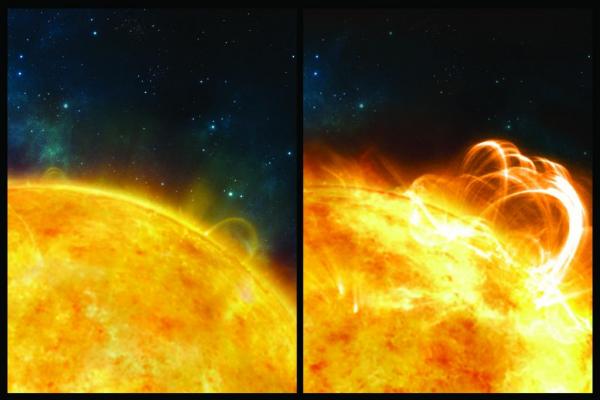WARWICK, England, Dec. 8 (UPI) — Researchers at University of Warwick located a solar superflare among stellar data collected by NASA’s Kepler space telescope. The massive burst featured wave patterns similar to flares emitted by our own sun.
In a new paper on the discovery, published in the Astrophysical Journal Letters, scientists suggest our own sun may be capable of a superflare — a flare 1,000 times stronger than any previously recorded.
Superflares aren’t exactly rare. They’re occasionally observed erupting from faraway stars. The latest was seen leaping from KIC9655129, a binary star system 1,500 light-years away. But nothing close to a superflare has ever been measured on our sun.
A solar flare packs the energy equivalent of 100 million megaton bombs; a stellar superflare is as power-packed as 100 billion megaton bombs.
The new observations, however, suggest superflares aren’t structurally unique and that the same violent potential exists within the chaos of the sun’s swirling electromagnetic fields.
“Our solar system is filled with plasma, or ionized gas, originating from the sun as a result of the solar wind and other more violent solar eruptions, such as solar flares,” study author Chloe Pugh, a researcher at Warwick’s Centre for Fusion, Space and Astrophysics, explained in a press release.
“Stars very similar to the sun have been observed to produce enormous flares, called superflares,” Pugh continued. “To give us a better indication of whether the Sun could produce a catastrophic superflare, we need to determine whether the same physical processes are responsible for both stellar superflares and solar flares.”
The study of solar flare patterns is called coronal seismology. Analysis of solar flare patterns show the phenomena are often marked by regular pulses that resemble waves. The wavelengths correspond with the region from which the flare is emitted.
Sometimes, solar flares feature multiple waves, called periodicities, superimposed on each other. A similar structure was observed in the recent superflare emitted by KIC9655129.
If the sun ever produced a superflare, it would likely prove devastating for Earth’s communication systems.
But while the new study confirmed the possibility of a sun-born superflare, researchers say the stellar conditions that would precipitate such an event are extremely rare on the sun.






